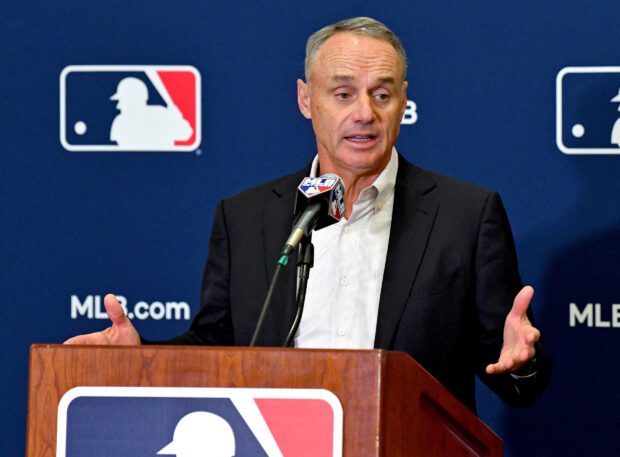
FILE PHOTO: Glendale, AZ, USA; Baseball commissioner Robert D. Manfred, Jr. answers questions from the media during spring training media day at the Glendale Civic Center. Jayne Kamin-Oncea-USA TODAY Sports
NEW YORK —Larger bases, a pitch clock and the elimination of the infield shift await fans as Major League Baseball (MLB) kicks off its regular season on Thursday with new rules designed to speed up games and put more balls in play.
It marks the biggest collection of changes to America’s “national pasttime” since Alexander Cartwright pioneered the sport in the 1800s and established a basic rubric that governs the game in ballparks across the country decades later.
“It’s the best game in the world – now, it’s even better,” declares “Breaking Bad” star Bryan Cranston in a new MLB ad campaign, part of the league’s charm offensive to get baseball purists to embrace change.
“This is the game we all want to see,” he says. “Get the ball, pitch the ball.”
For some players, it hasn’t been quite so simple.
Atlanta Braves shortstop Cal Conley was left in disbelief after a umpire called strike three on him for a clock violation last month, ending a spring training game against the Boston Red Sox in the bottom of the ninth inning with bases loaded.
The new rule gives the pitcher 15 seconds in between pitches with the bases empty and 20 seconds with runners on base. Hitters must be in the batters box with no less than eight seconds left on the timer, and there is a 30-second limit between batters – all changes designed to quicken play.
Others have taken to the new rules that were extensively tested in the minor leagues with ease.
“We’ve been game-planning this for basically a year now. We knew it’s coming,” New York Mets’ eight-time All-Star ace Max Scherzer said during a televised interview. “The pitcher has complete control of the situation and dictates the pace now.”
Another major change – outlawing the shift – will allow for more hits, making games more exciting for fans. With two infielders required on either side of second base, left-handed batters in particular may no longer see their best attempts absorbed by a wall of defenders, likely inflating batting averages.
The larger bases are intended to promote more base stealing, an exciting aspect of the game that has grown increasingly rare.
‘BIG DIFFERENCE’
The Houston Astros celebrate defeating the New York Yankees in game four of the American League Championship Series to advance to the World Series at Yankee Stadium on October 23, 2022 in the Bronx borough of New York City. Jamie Squire/Getty Images/AFP (Photo by JAMIE SQUIRE / GETTY IMAGES NORTH AMERICA / Getty Images via AFP)
The changes reflect a years-long campaign by MLB Commissioner Rob Manfred to speed things up amid concerns that fans – particularly the younger generation – have grown bored of the bloated length of game.
In 2003, the average time of a nine-inning game was two hours and 46 minutes, according to Elias Sports Bureau. By 2022, fans could expect an average time of three hours and three minutes across nine innings.
“If you’re a spectator, the game will not go four hours,” said baseball historian Peter Golenbock. “It makes a big difference to all the people who are leaving to buck the traffic in the seventh inning because it’s midnight.”
The author of “Whispers of the Gods: Tales from Baseball’s Golden Age, Told by the Men Who Played It” told Reuters that the rule changes would bring the sport closer to its heyday, when the pace was quicker.
An MLB memo obtained by Reuters last week showed the pitch clock was already having its intended effect.
After slightly less than a month of spring training games, the average game time had dropped 25 minutes from the previous year, according to a document from Senior Vice President of On-Field Operations Michael Hill.
The average number of violations per game also dropped from 2.03 in the first week to 1.03 by mid-March.
“You don’t want to be playing with your gloves and adjusting your hat and have the umpire scream strike one because you didn’t get in the box. You’ll do that once,” said Golenbock.
“I guarantee you, you’re not gonna do it twice.”

